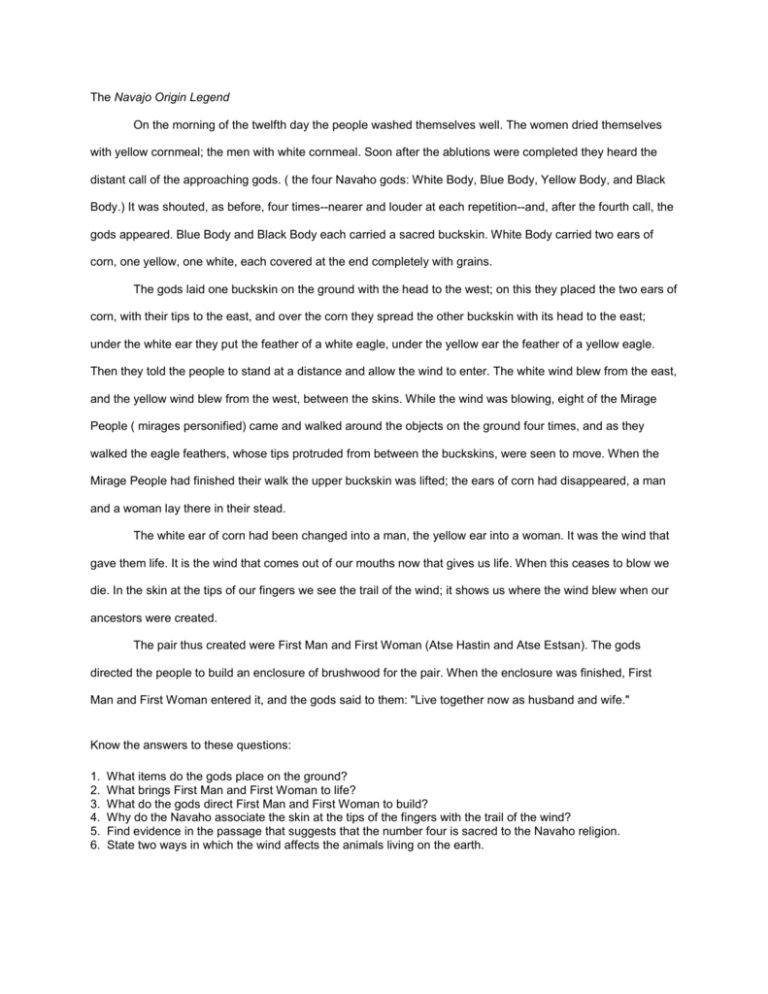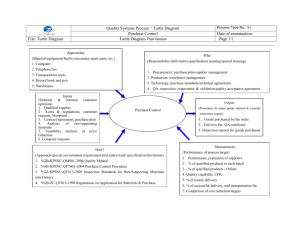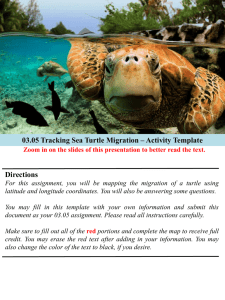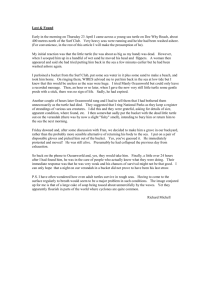Navajo Origin Legend navajo_origin_legend
advertisement

The Navajo Origin Legend On the morning of the twelfth day the people washed themselves well. The women dried themselves with yellow cornmeal; the men with white cornmeal. Soon after the ablutions were completed they heard the distant call of the approaching gods. ( the four Navaho gods: White Body, Blue Body, Yellow Body, and Black Body.) It was shouted, as before, four times--nearer and louder at each repetition--and, after the fourth call, the gods appeared. Blue Body and Black Body each carried a sacred buckskin. White Body carried two ears of corn, one yellow, one white, each covered at the end completely with grains. The gods laid one buckskin on the ground with the head to the west; on this they placed the two ears of corn, with their tips to the east, and over the corn they spread the other buckskin with its head to the east; under the white ear they put the feather of a white eagle, under the yellow ear the feather of a yellow eagle. Then they told the people to stand at a distance and allow the wind to enter. The white wind blew from the east, and the yellow wind blew from the west, between the skins. While the wind was blowing, eight of the Mirage People ( mirages personified) came and walked around the objects on the ground four times, and as they walked the eagle feathers, whose tips protruded from between the buckskins, were seen to move. When the Mirage People had finished their walk the upper buckskin was lifted; the ears of corn had disappeared, a man and a woman lay there in their stead. The white ear of corn had been changed into a man, the yellow ear into a woman. It was the wind that gave them life. It is the wind that comes out of our mouths now that gives us life. When this ceases to blow we die. In the skin at the tips of our fingers we see the trail of the wind; it shows us where the wind blew when our ancestors were created. The pair thus created were First Man and First Woman (Atse Hastin and Atse Estsan). The gods directed the people to build an enclosure of brushwood for the pair. When the enclosure was finished, First Man and First Woman entered it, and the gods said to them: "Live together now as husband and wife." Know the answers to these questions: 1. 2. 3. 4. 5. 6. What items do the gods place on the ground? What brings First Man and First Woman to life? What do the gods direct First Man and First Woman to build? Why do the Navaho associate the skin at the tips of the fingers with the trail of the wind? Find evidence in the passage that suggests that the number four is sacred to the Navaho religion. State two ways in which the wind affects the animals living on the earth. Borrowed from http://www.nkemontoh.com/Assignment%201_2.htm Lenni-Lenape Tradition The Wallum Olum One of the traditions of the Lenni- Lenape is the story of how their ancestors had come from a far off land and traveled with much hardship to find a quiet and peaceful home by the ocean. There is a documented (well painted) account of this story, called the Wallum Olum. It is controversial as a scholarly article, but I think it gives a genuine feel for the oral tradition, if not a historical account. The poetic translation was done in the 1830's by Constantine Samuel Rafinesque. It was reexamined in the 1980's by David McCutchen with a less poetical style and "approved" as an accurate retelling of the story of the original people. Follow this link to a site with more information:. THE LENNI-LENAPE AND THE "RED RECORD" The Rafinesque translation is in the romantic language of the 19th century, but it has a rhythm that sounds like a legend. At first in that place, at all times, above the earth, On the earth, was an extended fog, And there the great Manitio was. At first, forever, lost in space, everywhere, The great Manito was. He made the extended land in the sky, He made the sun, the moon, the stars. He made them all to move evenly. Then the wind blew violently, and it cleared, And the water flowed off far and strong, And groups of islands grew newly, and there remained. It was a rugged journey toward the sunrise and the edge of the sea. Prophetically, the Walum Olum ended with: Watcher was chief; he looked toward the sea, At this time, from north and south, the whites came, They are peaceful; they have great things. Who are they? Excerted from New Jersey - America's Main Road by John T. Cunningham - New York, 1966 Note: There is some serious doubt as to the truth behind "The Walum Olum", but I find it a fascinating story and an excellent example of Creation Myth. Follow this link to a discussion of the history of the story and some good links, regarding it. The Cedar Mesa Project Follow the link below to the new research presented that shows it to be untrue: "The Walum Olum was carefully studied by David Oestreicher and shown to be a made-up fiction by Rafinesque." Is it true or not? Source: http://www.usgennet.org/usa/nj/state/walum_olum.htm A portion of The Walam Olum: From The Lenape and their Legends by Daniel G. Brinton (1884) Be prepared to answer the following questions. 1. Who does the snake represent? 2. What do you suppose a "manito" is? 3. Who does the "grandfather of all beings" represent? 4. Briefly explain what part III is describing. 5. How would you describe the difference between "house-builders" and "hunters"? 6. What finally happens to the tribe? PART II. 1. Wulamo maskanako anup lennowak makowini essopak. Long ago there was a mighty snake and beings evil to men. 2. Maskanako shingalusit nijini essopak shawelendamep eken shingalan. This mighty snake hated those who were there (and) greatly disquieted those whom he hated. 3. Nishawi palliton, nishawi machiton, nishawi matta lungundowin. They both did harm, they both injured each other, both were not in peace. 4. Mattapewi wiki nihanlowit mekwazoan. Driven from their homes they fought with this murderer. 5. Maskanako gishi penauwelendamep lennowak owini palliton. The mighty snake firmly resolved to harm the men. 6. Nakowa petonep, amangam petonep, akopehella petonep. He brought three persons, he brought a monster, he brought a rushing water. 7. Pehella pehella, pohoka pohoka, eshohok eshohok, palliton palliton. Between the hills the water rushed and rushed, dashing through and through, destroying much. 8. Tulapit menapit Nanaboush maskaboush owinimokom linnwimokom Nanabush, the Strong White One, grandfather of beings, grandfather of men, was on the Turtle Island. 9. Gishikin-pommixin tulagis- hatten-lohxin. There he was walking and creating, as he passed by and created the turtle. 10. Owini linowi wemoltin, Pehella gahani pommixin, Nahiwi tatalli tulapin. Beings and men all go forth, they walk in the floods and shallow waters, down stream thither to the Turtle Island. 11. Amanganek makdopannek alendyuwek metzipannek. There were many monster fishes, which ate some of them. 12. Manito-dasin mokol-wichemap, Palpal payat payat wemichemap. The Manito daughter, coming, helped with her canoe, helped all, as they came and came. 13. Nanaboush Nanaboush wemimokom, Winimokom linnimokom tulamokom. [And also] Nanabush, Nanabush, the grandfather of all, the grandfather of beings, the grandfather of men, the grandfather of the turtle. 14. Linapi-ma tulapi-ma tulape- wi tapitawi. The men then were together on the turtle, like to turtles. 15. Wishanem tulpewi pataman tulpewi poniton wuliton. Frightened on the turtle, they prayed on the turtle that what was spoiled should be restored. 16. Kshipehelen penkwihilen, Kwamipokho sitwalikho, Maskan wagan palliwi palliwi. The water ran off, the earth dried, the lakes were at rest all was silent, and the mighty snake departed. PART III. 1. Pehella wtenk lennapewi tulapewini psakwiken woliwikgun wittank talli. After the rushing waters (had subsided) the Lenape of the turtle were close together, in hollow houses, living together there. 2. Topan-akpinep, wineu-akpi- nep,kshakan-akpinep, thupin akpinep. It freezes where they abode, it snows where they abode it storms where they abode, it is cold where they abode. 3. Lowankwamink wulaton wtakan tihill kelik meshautang sili ewak. At this northern place they speak favorably of mild, cool (lands), With many deer and buffaloes. 4. Chintanes-sin powalessin peyachik wikhichik pokwihil. As they journeyed, some being strong, some rich, they separated into house-builders and hunters; 5. Eluwi-chitanesit eluwi takauwesit, elowi chiksit, elowichik delsinewo. The strongest, the most united, the purest, were the hunters. 6. Lowaniwi, wapaniwi, shawaniwi, wunlceniwi, elowichik apakachik. The hunters showed themselves at the north, at the east, at the south, at the west. 7. Lumowaki, lowanaki tulpenaki elowaki tulapiwi linapiwi. In that ancient country, in that northern country, in that turtle country, the best of the Lenape were the Turtle men. 8. Wemiako yagawan tendki lakkawelendam nakopowa wemi owenluen atam. All the cabin fires of that land were disquieted, and all said to their priest, " Let us go. 9. Akhokink wapaneu wemoltin palliaal kitelendam aptelendam. To the Snake land to the east they went forth, going away, earnestly grieving. 10. Pechimuin shakowen' nungihillan lusasaki pikihil pokwihil akomenaki. Split asunder, weak, trembling, their land burned, they went, torn and broken, to the Snake Island. Source: A portion of The Walam Olum: From The Lenape and their Legends by Daniel G. Brinton (1884) PART II. 1. Wulamo maskanako anup lennowak makowini essopak. Long ago there was a mighty snake and beings evil to men. 2. Maskanako shingalusit nijini essopak shawelendamep eken shingalan. This mighty snake hated those who were there (and) greatly disquieted those whom he hated. 3. Nishawi palliton, nishawi machiton, nishawi matta lungundowin. They both did harm, they both injured each other, both were not in peace. 4. Mattapewi wiki nihanlowit mekwazoan. Driven from their homes they fought with this murderer. 5. Maskanako gishi penauwelendamep lennowak owini palliton. The mighty snake firmly resolved to harm the men. 6. Nakowa petonep, amangam petonep, akopehella petonep. He brought three persons, he brought a monster, he brought a rushing water. 7. Pehella pehella, pohoka pohoka, eshohok eshohok, palliton palliton. Between the hills the water rushed and rushed, dashing through and through, destroying much. 8. Tulapit menapit Nanaboush maskaboush owinimokom linnwimokom Nanabush, the Strong White One, grandfather of beings, grandfather of men, was on the Turtle Island. 9. Gishikin-pommixin tulagis- hatten-lohxin. There he was walking and creating, as he passed by and created the turtle. 10. Owini linowi wemoltin, Pehella gahani pommixin, Nahiwi tatalli tulapin. Beings and men all go forth, they walk in the floods and shallow waters, down stream thither to the Turtle Island. 11. Amanganek makdopannek alendyuwek metzipannek. There were many monster fishes, which ate some of them. 12. Manito-dasin mokol-wichemap, Palpal payat payat wemichemap. The Manito daughter, coming, helped with her canoe, helped all, as they came and came. 13. Nanaboush Nanaboush wemimokom, Winimokom linnimokom tulamokom. [And also] Nanabush, Nanabush, the grandfather of all, the grandfather of beings, the grandfather of men, the grandfather of the turtle. 14. Linapi-ma tulapi-ma tulape- wi tapitawi. The men then were together on the turtle, like to turtles. 15. Wishanem tulpewi pataman tulpewi poniton wuliton. Frightened on the turtle, they prayed on the turtle that what was spoiled should be restored. 16. Kshipehelen penkwihilen, Kwamipokho sitwalikho, Maskan wagan palliwi palliwi. The water ran off, the earth dried, the lakes were at rest all was silent, and the mighty snake departed. PART III. 1. Pehella wtenk lennapewi tulapewini psakwiken woliwikgun wittank talli. After the rushing waters (had subsided) the Lenape of the turtle were close together, in hollow houses, living together there. 2. Topan-akpinep, wineu-akpi- nep,kshakan-akpinep, thupin akpinep. It freezes where they abode, it snows where they abode it storms where they abode, it is cold where they abode. 3. Lowankwamink wulaton wtakan tihill kelik meshautang sili ewak. At this northern place they speak favorably of mild, cool (lands), With many deer and buffaloes. 4. Chintanes-sin powalessin peyachik wikhichik pokwihil. As they journeyed, some being strong, some rich, they separated into house-builders and hunters; 5. Eluwi-chitanesit eluwi takauwesit, elowi chiksit, elowichik delsinewo. The strongest, the most united, the purest, were the hunters. 6. Lowaniwi, wapaniwi, shawaniwi, wunlceniwi, elowichik apakachik. The hunters showed themselves at the north, at the east, at the south, at the west. 7. Lumowaki, lowanaki tulpenaki elowaki tulapiwi linapiwi. In that ancient country, in that northern country, in that turtle country, the best of the Lenape were the Turtle men. 8. Wemiako yagawan tendki lakkawelendam nakopowa wemi owenluen atam. All the cabin fires of that land were disquieted, and all said to their priest, " Let us go. 9. Akhokink wapaneu wemoltin palliaal kitelendam aptelendam. To the Snake land to the east they went forth, going away, earnestly grieving. 10. Pechimuin shakowen' nungihillan lusasaki pikihil pokwihil akomenaki. Split asunder, weak, trembling, their land burned, they went, torn and broken, to the Snake Island.








